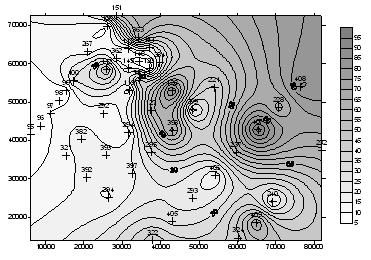ENG |RUS |
DonNTU>
Master's portal

|
THE LAST NAME Rudokvas Olga Nikolaevna
Faculty: Mineral and geological
Speciality: Ecological geology
Theme of master's work: Conformity to the law of spatial distribution of karst on the East-Êomsomol area of the Dokuchaevsk fluse and dolomite combine
Leader of work: Proscurnya Julia Anatolievna
Materials on the theme of master's work:
Biography |
Library |
Links |
Report about the search
Actuality of theme
Karst is one of the most dangerous natural processes on Earth from the suddenness of display as failures and settling of earthly surface, sometimes 50 - 100 meters arriving at and more in a diameter and in a depth. On geological terms approximately the third part of area of dry land of earth is in potential positions for development of karst. The processes of formation of karst are developed on a 60% territory of Ukraine, from them on 27% territories opened karst shows up (territories of Volinsk, Rovnensk, Ternopolsk, Donetsk, Lugansk and south regions of country). Karst substantially affects the landscape features of territory, its relief, flow, underground waters, rivers and lakes, soil-vegetable cover, economic activity of population. Other important ecological problem is that fact, that most sinkholes are used by a man for the upcast of different wastes, devices of unauthorized dumps and etc. In a number of places it results in substantial contamination of underground waters by toxic components and abbreviation of supplies of drinking-waters. All it conduces to the common worsening of ecological situation, to worsening of ecology-geological terms of territories.
Therefore, the study of the given geodinamical process is an important task both for Ukraine on the whole, and for the Donetsk region, where this phenomenon got wide distribution.
Target of work: Study of terms and features of development of carbonate karst on the East-Komsomol area of the Dokuchaevskogo fluso-dolomite combine.
Basic tasks of researches:
1) exposure of conformity to the law development of carbonate karsta on the East-komsomol area;
2) estimation the degree of karst breeds on the explored territory;
3) construction of cards of distribution of karst on the given area.
4) study of terms of development and distribution of mercury in sinkholes of district of Elenovskogo mestorogdeniiya.
Object of researches
By a research object in the given work the East-komsomol area DFDK was chosen. An area is located in south-west part of Donetsk plicate building and on the administrative division is found within the limits of the Volnovaha district of the Donetsk region.
The article of researches:
Superficial and underground karst in a the studied region is the article of researches.
Methods of researches:
1) statistical methods for determination of size of karst processes on territory;
2) methods of spatial analysis for the selection of the most credible and most dangerous areas of processes of karst;
3) cartographic methods for construction of cards of intensity of superficial and underground karst processes;
4) decoding of airphotos.
Scientific novelty of work:
1) the detailed description of size of karst processes carbonate arrays on territory of the East-komsomol area is given;
2) the existent method of construction of cards of distribution of karst and intensity of karst processes on territory was applied to the explored object.
THE PHENOMENA OF KARST ON AREA OF RESEARCH
Carbonate breeds of the studied district to a great extent fracturen and liable of karst process.
In wide development of karst in a district the thick network of tectonic violations and concomitant to them crack areas and areas of crushing is instrumental.
On the East-komsomol area, as well as on all Elenovsk district there is the superficial, or outward karst and internal karst.
Sinkholes and various deepening are the wide-spread forms of superficial karst. Development of superficial karst gradually diminishes with a depth. Most intensively to superficial karst the bar of carbonate breeds along the Yugno-Volnovahskogo fault and on the east flank of area is subject, where the absolute marks of surface achieve the minimum values (the picture 1).

|
Internal karst is difficult combination of cavities, cracks of different sizes and forms, often connected by channels. Cavities in the layer of limestone and dolomites on an area have sizes on a horizontal line from a few centimetres to 10-15 m, is rarer to 100 and even anymore, on a vertical line internal karst cavities usually do not exceed 10-15 m.
Swingeing majority of cavities is filled by sanstone and clay material of a different color with the blasted breeds. Also dolomite sand with the crystals of calcite and mercury is material of filling of cavities in dolomites.
The calculated values of linear coefficients of size of karst for every horizon (subhorizon) of breeds are presented in the table 1.

|
Thus, the difficult geological and tectonic structure of the explored karst region (presence of layers of soluble carbonate breeds, intensive tectonic disturbed arrays) was stipulated by wide distribution and variety of superficial (such, sinkholes, failures) and underground (caves, cavities and extended by karst processes cracks) karst forms.
To conformity to the law of distributing of superficial karst forms are conditioned, foremost, by hydrodynamic terms. The most closeness of superficial karst forms is observed in the areas of the tectonic violations characterized strong fracturing and increased circulation of underground waters.
The considerable economic losses and ecological harm from karst failures predetermine the necessity of deep study of karst and making of prognoses of his activity on the stages of planning and exploitation of building.
& Copy, DonNTU 2008
|